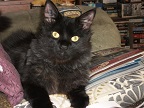WW31987Blog
Posts: 27
Joined: 7/24/2018
Status: offline

|
quote:
ORIGINAL: Randomizer
You can never have too many NORAD air defence scenarios, so thanks for this, am looking forward to running it through.
I spent a hell of a lot of time and effort researching North American air defence for my Deter, Detect, Defend 1962 scenario so a couple of points to accept or disregard as you like:
- The RCAF Sabres were not used at home but solely in Europe with the RCAF Air Division there (except for trials unit at RCAF Cold Lake and the OTU). By October 1961 they were all gone except for one squadron in northeast France that was converting to the CF-100 pending the arrival of the new CF-104.
- Until the CF-101B Voodoos became operational the Canadian contribution to NORAD was the CF-100 Clunk. The final version (Mk-V) was to be equipped with AIM-7 Sparrows but the principle anti-bomber/air intercept weapon for the Mk-IV was the Mighty Mouse rockets and internal guns. The CWDB has the Mk-V as I recall, it might make a suitable "what if?" and are likely to be more effective than the FFRs and far better than the guns-only loadouts. The first RCAF Voodoos became operational in October 1961 at RCAF Namao, just north of Edmonton, AB, they would not reach RCAF Bagotville and RCAF Chatham until into 1962 and would not get their nuclear AIR-2 Genies until 1965 or so.
- RCAF Greenwood had no NORAD role and was home to two of the CP-107 Argus LRMP squadrons under RCN operational control.
- Harmon AFB was a SAC base for tankers. US interceptors regularly staged out of RCAF Gander and Goose but neither had special weapon storage facilities.
- Nukes for the Nike Hercules were generally restricted to the Regular Army air defence batteries as few of the National Guard units could be certified for nuclear weapons. Less than 10% of the operational missiles were fitted with the W31 warhead and these were primarily used by the Hercules batteries in Florida and Alaska.
- The Soviets cannot attack the Single Unit airfields. Presumably the beacon markers are there to provide a target but hitting Single Unit Airfields can yield some odd and unsatisfactory results and using markers mean that follow-on attacks are impossible. Most post Cold War sources indicate that Soviet nuclear targeting was almost exclusively counter-value, that is cities/industry and civilian infrastructure. The primary military targets were Army bases and ports to interdict the reinforcement of Europe. Targeting SAC bases was almost certainly never Red doctrine as they realized that the birds would have flown by the time the missiles arrived.
- Suggest that you use the Drop Target command then Clear Log and save to render the Soviet bases invisible.
- Hopefully you will consider side names other than Blue and Red...
-C
First off, I'd like to tell you how much I've enjoyed playing your Deter, Detect, & Defend scenario.  It's always been one of my favorite CMANO scenarios. I actually started working on this one before yours came out, believe it or not. Then it was pushed to the side for a few years. Just recently I pulled it out and started fooling around with it some. I've read your points and since you've taken the time to lay them out, it's only fair I respond in kind. It's always been one of my favorite CMANO scenarios. I actually started working on this one before yours came out, believe it or not. Then it was pushed to the side for a few years. Just recently I pulled it out and started fooling around with it some. I've read your points and since you've taken the time to lay them out, it's only fair I respond in kind.
- I did not know this about the Sabres. 1961 seems like it was a tricky time for the RCAF. Transition time, if you will with a lot of airframe type turnover going on. I can play around with the orbat a bit and probably come up with a replacement. But I'll sure miss those Sabres 
- I should've indicated that the -101s I had based up in Canada are USAF birds and not the Canadian ones. A little bit of a cheat on my part since originally I used CF-101s until I realized they weren't in the RCAF inventory in large numbers by October, 1961. So the player should consider the Voodoos in Canada to be USAF/ANG aircraft that were dispersed there as the crisis deepened.
- Yep, you're right about RCAF Greenwood, and Harmon as well. Again, the dispersal issue. I couldn't include every airbase where fighters would've been dispersed. It would've crammed up the scenario unnecessarily, so I used a handful of bases in Canada and the US rather than the actual number of dispersal fields that would've been used in reality. I can fool around with the loadouts at these bases and remove the special weapons to fix the lack of special weapons facilities there. Before I do that, I'll do a bit of research and see if I can figure out what the deal was with fighter dispersal and the nuclear-tipped air-to-air missiles.
-Thanks for the insight on the Nikes and the nukes. That's worth a revision or two in my scenario.
- The single unit airfield issue has been a pain. That's why I included the beacon markers, you're right. And the results of some of the attacks is unsatisfactory to say the least. I'm searching for a solution aside from turning every single unit airfield into a fully equipped airbase. That will probably slow down the scenario significantly.
-I'll try that out to keep the Soviet bases invisible. Thanks!
-Sorry, but I always use Red and Blue as my sides. Not always fun, but I grew used to it back in the day. Might be time for a change though. 
|
 Printable Version
Printable Version









 It's always been one of my favorite CMANO scenarios. I actually started working on this one before yours came out, believe it or not. Then it was pushed to the side for a few years. Just recently I pulled it out and started fooling around with it some. I've read your points and since you've taken the time to lay them out, it's only fair I respond in kind.
It's always been one of my favorite CMANO scenarios. I actually started working on this one before yours came out, believe it or not. Then it was pushed to the side for a few years. Just recently I pulled it out and started fooling around with it some. I've read your points and since you've taken the time to lay them out, it's only fair I respond in kind. 

 New Messages
New Messages No New Messages
No New Messages Hot Topic w/ New Messages
Hot Topic w/ New Messages Hot Topic w/o New Messages
Hot Topic w/o New Messages Locked w/ New Messages
Locked w/ New Messages Locked w/o New Messages
Locked w/o New Messages Post New Thread
Post New Thread